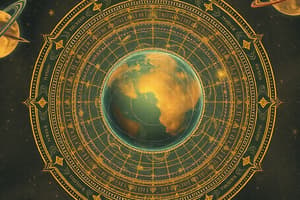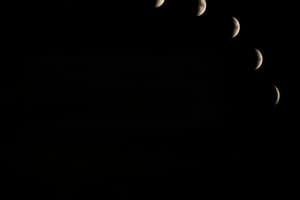Podcast
Questions and Answers
What causes the varying seasons on Earth?
What causes the varying seasons on Earth?
- The distance of Earth from the Sun
- The rotation of Earth on its axis
- The revolution of Earth around the Sun (correct)
- The gravitational pull of the Moon
During which phase of the Moon is it not visible from Earth?
During which phase of the Moon is it not visible from Earth?
- New Moon (correct)
- Waxing Gibbous
- Last Quarter
- Waning Crescent
Which of the following correctly describes a solar eclipse?
Which of the following correctly describes a solar eclipse?
- The Sun is obscured by Earth's shadow
- The Moon is fully illuminated
- The Moon casts a shadow on Earth (correct)
- Earth casts a shadow on the Moon
Which planet is known for having prominent rings?
Which planet is known for having prominent rings?
What is the primary process by which plants convert sunlight into food?
What is the primary process by which plants convert sunlight into food?
Which layer of the Sun is visible to the naked eye?
Which layer of the Sun is visible to the naked eye?
What are meteoroids that survive their passage through Earth's atmosphere called?
What are meteoroids that survive their passage through Earth's atmosphere called?
What is the concept describing the beginning of the universe approximately 15 billion years ago?
What is the concept describing the beginning of the universe approximately 15 billion years ago?
What is the main difference between rotation and revolution?
What is the main difference between rotation and revolution?
Which of the following best describes a solar eclipse?
Which of the following best describes a solar eclipse?
What characterizes a comet as opposed to an asteroid?
What characterizes a comet as opposed to an asteroid?
What are the Jovian planets known for?
What are the Jovian planets known for?
Which phase of the Moon occurs when it is between the Earth and the Sun?
Which phase of the Moon occurs when it is between the Earth and the Sun?
What is the primary advantage of the Sun's influence on Earth?
What is the primary advantage of the Sun's influence on Earth?
What process occurs in the core of the Sun?
What process occurs in the core of the Sun?
What is the name given to the study of the universe's origins and structure?
What is the name given to the study of the universe's origins and structure?
Which phenomenon is caused by the interaction of solar wind with Earth's atmosphere?
Which phenomenon is caused by the interaction of solar wind with Earth's atmosphere?
What event initiated the universe according to the Big Bang Theory?
What event initiated the universe according to the Big Bang Theory?
Flashcards
Earth's Rotation
Earth's Rotation
The spinning of Earth on its axis, resulting in day and night.
Earth's Revolution
Earth's Revolution
Earth's orbit around the Sun, causing the seasons due to the tilt of Earth's axis.
Earth's Axis
Earth's Axis
The tilted line Earth spins on, causing the variation in seasons.
Solar Eclipse
Solar Eclipse
Signup and view all the flashcards
Lunar Eclipse
Lunar Eclipse
Signup and view all the flashcards
Sun's Core
Sun's Core
Signup and view all the flashcards
Photosphere
Photosphere
Signup and view all the flashcards
Big Bang Theory
Big Bang Theory
Signup and view all the flashcards
Astronomical Unit (AU)
Astronomical Unit (AU)
Signup and view all the flashcards
Asteroid
Asteroid
Signup and view all the flashcards
Asteroid Belt
Asteroid Belt
Signup and view all the flashcards
Astronomy
Astronomy
Signup and view all the flashcards
Aurora Borealis
Aurora Borealis
Signup and view all the flashcards
Axis
Axis
Signup and view all the flashcards
Galaxy
Galaxy
Signup and view all the flashcards
Big Bang
Big Bang
Signup and view all the flashcards
Chromosphere
Chromosphere
Signup and view all the flashcards
Comet
Comet
Signup and view all the flashcards
Study Notes
Planetary Motion
- Earth rotates on its axis, causing day and night.
- Earth revolves around the Sun, causing the seasons.
- Earth's tilted axis is responsible for varying seasons.
Moon Phases
- New Moon: Moon is positioned between the Earth and Sun, making it invisible.
- Waxing Crescent: A small sliver of the Moon becomes visible, growing larger.
- First Quarter: Half of the Moon is illuminated.
- Waxing Gibbous: More than half of the Moon is lit, nearing a full moon.
- Full Moon: The entire face of the Moon is visible.
- Waning Gibbous: The illuminated portion of the Moon starts to shrink from full.
- Last Quarter: Half of the Moon is visible, opposite to the first quarter.
- Waning Crescent: Only a small sliver of the Moon is illuminated, decreasing in size.
Eclipses
- Solar Eclipse: The Moon passes between the Sun and Earth, blocking the Sun's light.
- Lunar Eclipse: Earth passes between the Sun and Moon, blocking sunlight from reaching the Moon.
The Planets
- Planets in order from the Sun: Mercury, Venus, Earth, Mars, Jupiter, Saturn, Uranus, Neptune (MVEMJSUN).
- Each planet has unique characteristics regarding size, composition, and atmosphere. Examples include Earth's habitability, Mars' largest volcano, Jupiter's gas nature, and Saturn's rings.
Effects of the Sun on Earth
- The Sun provides essential energy for all life.
- Photosynthesis relies on sunlight for plants to create food.
- The Sun's gravity maintains Earth in its orbit.
- Ultraviolet radiation, while harmful, plays a part in Vitamin D production.
- Solar energy is harnessed from the Sun.
- Earth's tilt, along with the Sun's position, causes the seasons.
- Eclipses happen when the Sun, Earth, and Moon align.
Structure of the Sun
- The Sun's core is the central, hottest region where nuclear fusion occurs.
- Hot gases rise and cool within the Sun.
- The photosphere is the visible surface of the Sun.
- The chromosphere is a layer above the photosphere, glowing red.
- Solar flares and prominences are eruptions and loops of gas.
- The corona is the outermost, exceedingly hot, glowing layer.
Other Objects in the Universe
- Moons are natural satellites of planets.
- Satellites are artificial objects orbiting planets.
- Meteoroids are small rocks in space.
- Meteors are meteoroids burning up in Earth's atmosphere.
- Meteorites are meteors that collide with Earth's surface.
The Big Bang
- The universe originated from a dense and hot point, expanding for approximately 15 billion years.
The James Webb Telescope
- The James Webb Telescope is a space telescope providing high-quality images of distant parts of the universe.
Terminology
- Astronomical Unit (AU): The distance from Earth to the Sun.
- Asteroid: A small, rocky body, often found in the asteroid belt.
- Asteroid Belt: Located between Mars and Jupiter, composed primarily of asteroids.
- Astronomy: The scientific study of celestial objects.
- Aurora Borealis: The Northern Lights, caused by solar wind.
- Axis: The imaginary line Earth rotates around.
- Galaxy: A vast system of stars, planets, and other celestial objects.
- Big Bang: The widely accepted theory describing the universe's origin.
- Chromosphere: A layer in the Sun's atmosphere.
- Comet: An icy body that develops a tail when nearing the Sun.
- Constellation: A group of stars appearing as a pattern.
- Core: The central, hottest part of the Sun.
- Corona: The outermost layer of the Sun's atmosphere.
- Cosmology: The study of the universe's origins, evolution, and structure.
- Crater: A hole formed by a meteor impact.
- Crescent: A phase of the moon that is less than half illuminated.
- Eclipse: When one celestial body blocks another's light.
- Fusion: The process where hydrogen atoms transform into helium in stars.
- Galileo Galilei: Renowned scientist who improved the telescope.
- Geocentric: An Earth-centered model of the universe.
- Gibbous: A phase of the moon where more than half is illuminated.
- Gravity: The force of attraction between objects with mass.
- Heliocentric: A Sun-centered model of the universe.
- International Space Station (ISS): A space station orbiting Earth.
- James Webb Telescope: A powerful space telescope for distant observations.
- Jovian Planets: Gas giants (Jupiter, Saturn, Uranus, Neptune).
- Light Year: The distance light travels in one year.
- Luminous: Emitting light.
- Meteor: A meteoroid burning up in Earth's atmosphere.
- Meteorite: A meteoroid that survives atmospheric entry and lands on Earth.
- Meteoroid: A small rock or particle in space.
- Milky Way: Our galaxy.
- Moon: Earth's natural satellite.
- Orbit: The path of an object moving around another.
- Photosphere: The visible surface of the Sun.
- Planet: A celestial body orbiting a star.
- Polaris: The North Star, near Earth's north pole.
- Revolution: Earth's journey around the Sun.
- Rotation: Earth's spinning motion about its axis.
- Satellite: A natural or artificial object orbiting a planet or star.
- Solar Flare: A sudden burst of energy from the Sun.
- Solar Prominence: A large loop of gas emanating from the Sun.
- Solar System: The Sun and all the objects orbiting it.
- Solar Winds: Charged particles emitted by the Sun.
- Star: A luminous celestial object.
- Sunspot: Dark regions on the Sun's surface.
- Universe: Everything that exists, encompassing all matter and energy.
- Waning: Decreasing in size or illumination (e.g., phases of the Moon).
- Waxing: Increasing in size or illumination (e.g., phases of the Moon).
Space Review Questions
-
Rotation vs. Revolution:
- Rotation: Earth spinning on its axis (causes day and night).
- Revolution: Earth orbiting the Sun (causes seasons).
-
Stars' Movement:
- Stars appear to move from east to west across the sky.
- Polaris (North Star) remains nearly stationary.
-
Moon Phases:
- New Moon: Moon positioned between Earth and Sun.
- Full Moon: Earth positioned between Sun and Moon.
-
Eclipse Sketches:
- Solar Eclipse: Moon blocks the Sun's light.
- Lunar Eclipse: Earth blocks sunlight from reaching the Moon.
-
Planet Characteristics:
- Specific details about each planet: Mercury, Venus, Earth, Mars, Jupiter, Saturn, Uranus, Neptune.
-
Sun's Influence on Earth:
- Benefits and drawbacks of solar energy and radiation.
-
Sun’s Cross Section Sketch:
- Descriptions of various layers of the Sun (core, photosphere, chromosphere, corona) and processes happening within them.
-
Comets vs. Asteroids:
- Differences between comets (icy bodies) and asteroids (rocky bodies).
- Location of the asteroid belt.
-
Meteors, Meteoroids, Meteorites:
- Definitions of meteoroids, meteors, and meteorites.
- Formation of craters.
-
Big Bang Theory:
- Universe's beginning as a dense, hot point.
- Evidence supporting the Big Bang theory from redshift of galaxies and cosmic microwave background radiation.
Studying That Suits You
Use AI to generate personalized quizzes and flashcards to suit your learning preferences.




